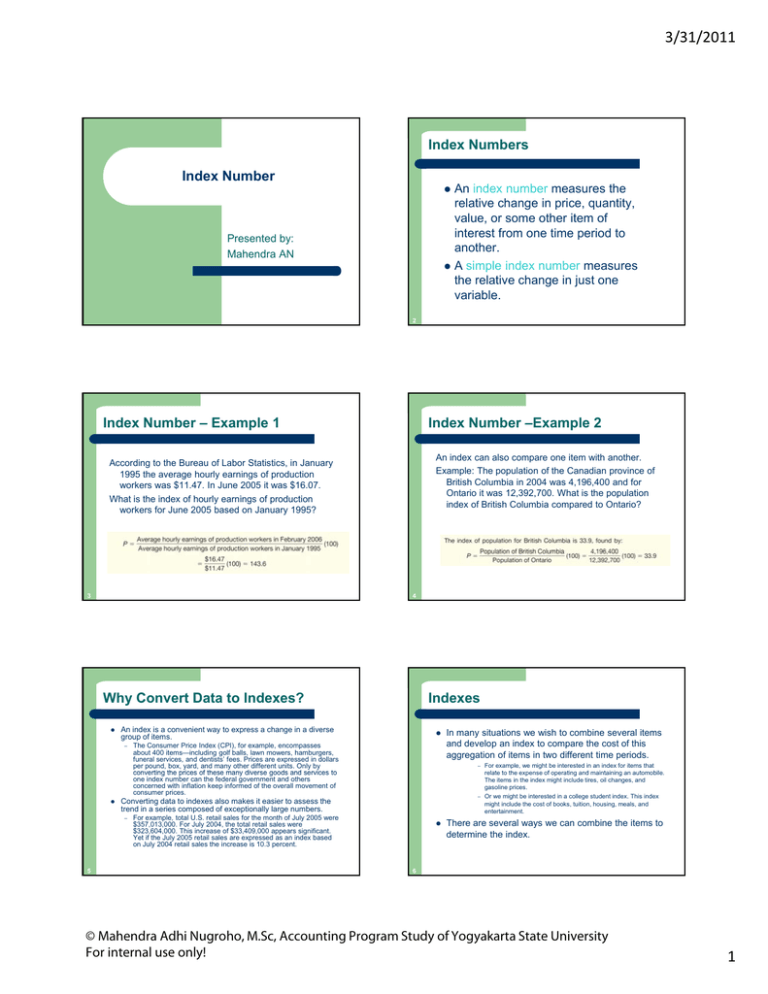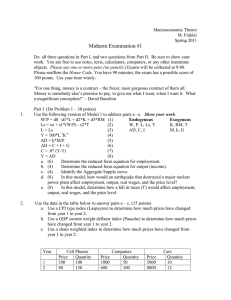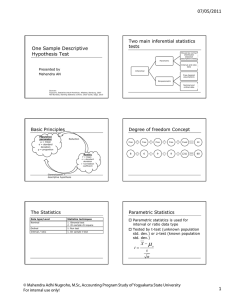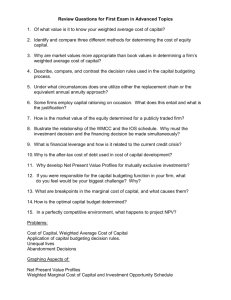3/31/2011 Index Number Index Numbers
advertisement

3/31/2011 Index Numbers Index Number An index number measures the relative change in price, quantity, value, or some other item of interest from one time period to another. z A simple index number measures the relative change in just one variable. z Presented by: Mahendra AN 2 Index Number – Example 1 Index Number –Example 2 An index can also compare one item with another. Example: The population of the Canadian province of British Columbia in 2004 was 4,196,400 and for , , What is the population p p Ontario it was 12,392,700. index of British Columbia compared to Ontario? According to the Bureau of Labor Statistics, in January 1995 the average hourly earnings of production workers was $11.47. In June 2005 it was $16.07. Wh t is What i th the iindex d off h hourly l earnings i off production d ti workers for June 2005 based on January 1995? 3 4 Why Convert Data to Indexes? z An index is a convenient way to express a change in a diverse group of items. – z z The Consumer Price Index (CPI), for example, encompasses about 400 items—including golf balls, lawn mowers, hamburgers, funeral services, and dentists’ fees. Prices are expressed in dollars per pound, box, yard, and many other different units. Only by converting the prices of these many diverse goods and services to one index number can the federal government and others concerned with inflation keep informed of the overall movement of consumer prices. In many situations we wish to combine several items and develop an index to compare the cost of this aggregation of items in two different time periods. For example, we might be interested in an index for items that relate l t tto the th expense off operating ti and d maintaining i t i i an automobile. t bil The items in the index might include tires, oil changes, and gasoline prices. – Or we might be interested in a college student index. This index might include the cost of books, tuition, housing, meals, and entertainment. – Converting data to indexes also makes it easier to assess the trend in a series composed of exceptionally large numbers. – 5 Indexes For example, total U.S. retail sales for the month of July 2005 were $357,013,000. For July 2004, the total retail sales were $323,604,000. This increase of $33,409,000 appears significant. Yet if the July 2005 retail sales are expressed as an index based on July 2004 retail sales the increase is 10.3 percent. z There are several ways we can combine the items to determine the index. 6 © Mahendra Adhi Nugroho, M.Sc, Accounting Program Study of Yogyakarta State University For internal use only! 1 3/31/2011 Unweight index number Index numbers Price index number Simple aggre gative Simple average Laspeyr es Paasch e Drobisc h Irving Fisher Edgewo rth Simple agregrative z Simple agregrative z Relative average z Relative average Chain index number Weighted g Unweighted Quantity index number z Walsh Fixedweight aggreg ative Weighted Index Number Weighted Index Number (cont.) Basic formula 2. Paasche z z Is a value index Weighted by quantity 1. Laspeyres z Weighted by quantity on base year Weighted Index Number (cont.) 4. Irving Fisher z z Is called ideal index Geometric mean of Laspayer’s and Paasche’s 5. Edgeworth z Weighted by sum of quantity on base year and quantity on given year z Weighted by quantity on given year 3. Drobisch z Aritmatic mean of Laspayer’s and Paasche’s Weighted Index Number (cont.) 6. Walsh z Give the alternative 7. Fix weight aggregative index Fix weight value z Not use either given year or base year. z z Weight average method z Weight is multiplication of price and quantity. Could be base year or given year © Mahendra Adhi Nugroho, M.Sc, Accounting Program Study of Yogyakarta State University For internal use only! 2 3/31/2011 Chain Index Number z z z z Index number use A binary comparison that is chain-arranged Comparing index with previous year Counted year by year and last year period is used as base year More flexible, easily to know variable changes z z z z Purchasing power measurement Deflation Escalators Studying bunnies conditions SYUKUR DAN TAFAKUR mari kita cuci diri kita dengan peluh sendiri di siang hari dan mari kita basuh hati kita dengan air mata sendiri di malam hari Jeihan S. (1999 ) 15 © Mahendra Adhi Nugroho, M.Sc, Accounting Program Study of Yogyakarta State University For internal use only! 3






